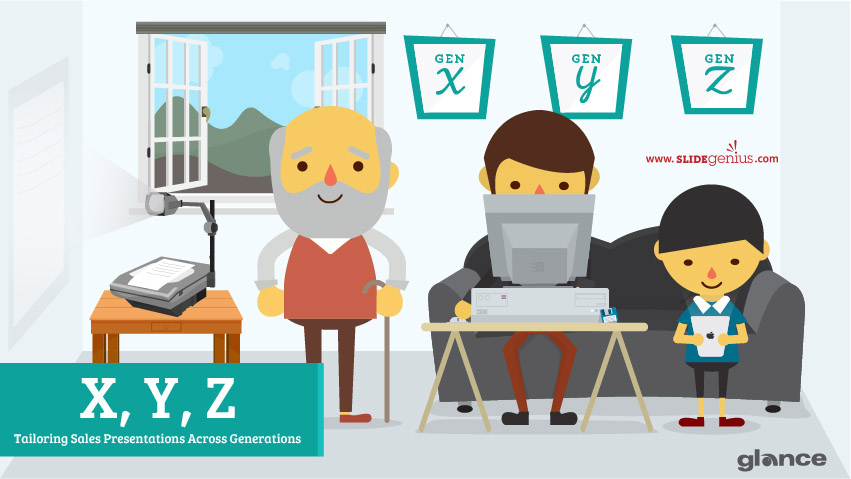Building rapport with customers brings any business ahead of the competition.
However, customer relationships don’t happen instantly. They require in-depth research, planning, and – most of all – preparation.
Sales professionals must understand and address their potential prospects’ concerns to turn them into buying customers. In fact, a recent study from the Harvard Business Review recent study showed that US companies lose 50% of their customers every five years due to poor customer care.
Make your sales presentations stand out and your sales soar by knowing your audience.
Who makes up your audience?
Audience members have different characteristics, behaviors, and needs.
According to Dona Vitale, President of Strategic Focus, Inc.,
“The purpose of [the audience segmentation analysis] approach is to identify those in the overall population who’ll be most likely to appreciate, value, and buy into an attempt to convince them.”
A good place to start is demographic targeting. This strategy identifies potential consumers based on characteristics such as gender, age, educational attainment, profession, and affiliations. With this information, you can determine who, where, and how to market your product.
However, this data may be too limited for you to properly analyze customer insights. That’s why you also need to explore other factors that influence their buying decisions – quality over quantity, as well as satisfaction and usability.
Read: 10 Ways to Exceed Expectations in Customer Service
This is where psychographic targeting comes in. Psychographic targeting measures non-visible characteristics that are more subjective in nature, including upbringing, lifestyle patterns, interests, hobbies, and loyalties. Moreover, these traits change depending on which generation a person belongs to.
Combining both strategies empowers you to hone in on your buying persona.
What generation is your audience from?
According to The Nielsen Company, each generation of the US population has unique wants and needs that marketers and retailers should address differently.
Gen X
Gen X-ers were born roughly between 1965 and 1980. These adults were raised in an era of political incompetence, activism, and then-emerging technology. They are the first generation of “latchkey” kids who learned independence early in life.
Having survived these challenging times, they place great value on education and knowledge. They form families with practical and value-oriented sensibilities. In fact, 29% of Gen X-ers obtained a bachelor’s degree, which is 6% higher than that of their parent generation.
Gen Y
Born in the 1980s to early 1990s, the “millennials” witnessed the rise of social networking and technological devices. They grew up with protective parents who sheltered them from the evils of the modern world. Economic activities peaked during the Gen Y period, making them the most avid consumers among all generations, more interested in experiences than products.
A research study by Eventbrite said that 78% of millennials would choose to spend money on a desirable experience or event over buying something concrete.
Gen Z
The youngest generation was born anywhere from the mid-1990s to the present. Also called the “Internet generation” or “iGeneration,” they are accustomed to multiple high-tech information sources to support daily activities.
Gen Z-ers embrace cultural diversity and value the family unit, cultivating smarter and more responsible decision-making at a younger age. This is the generation where kids influence parents’ purchasing decisions, giving birth to the word “kidfluence.”
How will you reach out to them?
Besides understanding their needs and possible concerns, you have to reach out to them by addressing the topmost consumer issue:
Why should they buy your product?
Learn your prospect’s goal for a presentation
Meeting customer’s expectations means satisfying your customers.
Evaluate the product or service you’re selling along with the benefits it can offer. Assess whether it’s a high or low priority for your audience, and if they’re likely to buy your product.
For the Gen X-ers, trust and engagement are extremely necessary.
Since they have seen political issues and may have endured broken families during their youth, they’re more likely to be cynical during the decision-making process, making them doubt products, ads, and brands.
Reach their level of pragmatism by introducing your product as if it was engineered specifically for their tasks. Since they are output- and results-driven, try citing results and product benefits.
Acknowledge audience attitudes and concerns
Use demographic and psychographic data as your frame of reference. Take note of the biases and concerns that might affect how they receive your message.
Having grown up during the booming economy and technology, the Gen Y segment searches for knowledge and growth.
Appeal to their appreciation of user experiences and novelty options to stimulate a fun and collaborative discussion. Since 55% of millennials watch videos several times a day on various devices, try incorporating video and other forms of visual engagement into your presentation.
Plan for your persona
Aligning your communication style according to your prospects’ personal profiles is another must. Do they prefer a seller approach or does appearing as a consultant attract them more?
For Gen Z — those who see technology as the norm for education and learning — use the “edutainment” approach, adopting technology-based strategies to keep them entertained and educated at the same time.
“Their high dependency on high-tech communication constricts their attention span, making them live in at a much more surface level,” says Dr. Edward Hallowell, Psychiatrist.
Experiment with high-definition visuals to feed their desire of solving problems by themselves while enjoying it at the same time. For inspiration, look to how videos and animations are used in the context of gaming.
Bridge the generations
Being aware of your target audiences’ basic profiles keeps you ahead of the competition.
Each generation has a distinct upbringing, behavior, and lifestyle, all of which influence their purchasing decisions. Identify these factors before you start creating your presentation in order to create a sales strategy that meets each generation’s unique wants and desires.
Soon, you’ll know audience segmentation as well as you know your ABCs – helping you appeal to the XYZs.
Once your customers have been hooked, are you ready to provide them with outstanding customer care? Want some great tips about how to stand above the crowd? Download your free eBook today: Counting the Customer: The Complete Guide to Dynamite Customer Care.
Are you ready to discover how Glance can improve customer engagement and increase sales for your own business?
Sign up for your personalized Glance demo today!
About Glance Networks
Glance helps enterprise organizations create the ultimate customer experience with smart, omni-channel visual engagement solutions based around integrated cobrowse, screen share, and one-way agent video. We are one of the world’s simplest, most reliable and secure platforms that enable companies to see, show and share anything online, creating a frictionless path to great experiences in sales, support and customer service. The result is improved customer satisfaction and loyalty, increased revenue growth and operational savings. From financial services and healthcare to retail and travel and leisure, even the most advanced technology and SaaS organizations – we transform the customer experience for today’s business. Learn More »
About the author: Rick Enrico
Rick Enrico is the CEO and Founder of SlideGenius, Inc., a presentation design agency with clients all over the world. He is also a blog enthusiast with a particular interest in Internet Marketing, writing full-time about how to become a more effective presenter on the SlideGenius blog. He currently oversees an experienced team of talented designers, software developers and marketing professionals that specialize in creating custom corporate presentations and cloud publishing applications. You can connect with him on LinkedIn and Twitter.
References
DeMers, Jayson. “6 Steps To Decoding Your Target Audience.” Forbes. August 27, 2013. Accessed August 6, 2015
King, Connie. “Knowing Your Audience – Demographics & Psychographics.” The Market Pro. January 2011. Accessed August 6, 2015.
“Marketing to the Generations.” Journal of Behavioral Studies in Business, n.d. Accessed August 7, 2015.
“Know Your Audience.” The Total Communicator. n.d. Accessed August 6, 2015.
Wilson, Elizabeth. “Know Your Target Market.” Entrepreneur. June 19, 2009. Accessed August 6, 2015.
“Generational Differences Chart.” West Midland Family Center, n.d. Accessed August 11, 2015.
SaveSave
SaveSave




